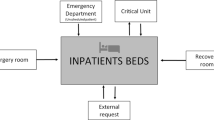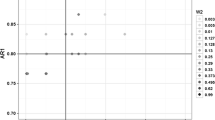Abstract
In this paper, a multi-objective decision aiding model is introduced for allocation of beds in a hospital. The model is based on queuing theory and goal programming (GP). Queuing theory is used to obtain some essential characteristics of access to various departments (or specialities) within the hospital. Results from the queuing models are used to construct a multi-objective decision aiding model within a GP framework, taking account of targets and objectives related to customer service and profits from the hospital manager and all department heads. The paper describes an application of the model, dealing with a public hospital in China that had serious problems with loss of potential patients in some departments and a waste of hospital beds in others. The performance of the model and implications for hospital management are presented.






Similar content being viewed by others
References
Blake JT and Carter MW (2002). A goal programming approach to strategic resource allocation in acute care hospital. Eur J Opl Res 140(3): 541–561.
Cooper JK and Corcoran TM (1974). Estimating bed needs by means of queuing theory. N Engl J Med 291(22): 404–405.
Cote MJ (2005). A note on ‘Bed allocation techniques based on census data'. Socio-Econ Plann Sci 39: 183–192.
Esogbue AO and Singh AJ (1976). A stochastic model for an optimal priority bed distribution problem in a hospital ward. Opns Res 24(5): 884–898.
Fetter RB and Thompson JD (1965). The simulation of hospital systems. Opns Res 13(5): 689–711.
Gass SI (1986). A process for determining priorities and weights for large-scale linear goal programmes. J Opl Res Soc 37(8): 779–785.
Gorunescu S, McClean SI and Millard PH (2002). A queuing model for bed-occupancy management and planning of hospitals. J Opl Res Soc 53: 19–24.
Green LV and Nguyen V (2001). Strategies for cutting hospital beds: the impact in patient service. Health Servs Res 36(2): 421–442.
Gross D and Harris CM (1985). Fundamentals of Queueing Theory, 2nd edn. John Wiley & Sons: USA.
Jones DF and Tamiz M (1995). Improving the flexibility of goal programming via preference modeling techniques. Omega 23: 41–48.
Kao PC and Tung G (1981). Bed allocation in a public health care delivery system. Mngt Sci 27(5): 507–520.
Keown AJ and Martin JD (1976). An integer GP model for capital budgeting in hospitals. Financ Mngt 5(3): 28–35.
Kim S-C, Horowitz I, Young KK and Buckley TA (2000). Flexible bed allocation and performance in the intensive care unit. J Opns Mngt 18: 427–443.
Lapierre SD, Goldsman D, Cochran R and DuBow J (1999). Bed allocation techniques based on census data. Socio-Econ Plann Sci 33: 25–38.
Oddoye JP (2006). Efficient resource planning in a medical assessment unit using goal programming and simulation. PhD thesis, University of Portsmouth, UK.
Oddoye JP, Yaghoobi MA, Tamiz M, Jones DF and Schmidt P (2007). A multi-objective model determine efficient resource levels in a medical assessment unit. J Opl Res Soc 58: 1563–1573.
Romero C (1991). Handbook of Critical Issues in Goal Programming, 1st edn. Pergamon Press: Oxford.
Saaty TL (1994). How to make a decision: the analytic hierarchy process. Interfaces 24(6): 19–43.
Tamiz M, Jones DF and Romero C (1998). Goal programming for decision making: An overview if the current state-of-the-art. Eur J Opl Res 111: 568–581.
Tamiz M, Mirrazavi SK and Jones DF (1999). Extensions of Pareto efficiency analysis to integer goal programming. Omega, Int J Mngt Sci 27: 179–188.
Winston WL (2004). Operations Research: Applications and Algorithms, 4th edn. Duxbury Press: Belmont, CA.
Acknowledgements
We thank the anonymous referee of this article for the useful comments that have helped improve this paper.
Author information
Authors and Affiliations
Corresponding author
Rights and permissions
About this article
Cite this article
Li, X., Beullens, P., Jones, D. et al. An integrated queuing and multi-objective bed allocation model with application to a hospital in China. J Oper Res Soc 60, 330–338 (2009). https://doi.org/10.1057/palgrave.jors.2602565
Received:
Accepted:
Published:
Issue Date:
DOI: https://doi.org/10.1057/palgrave.jors.2602565




